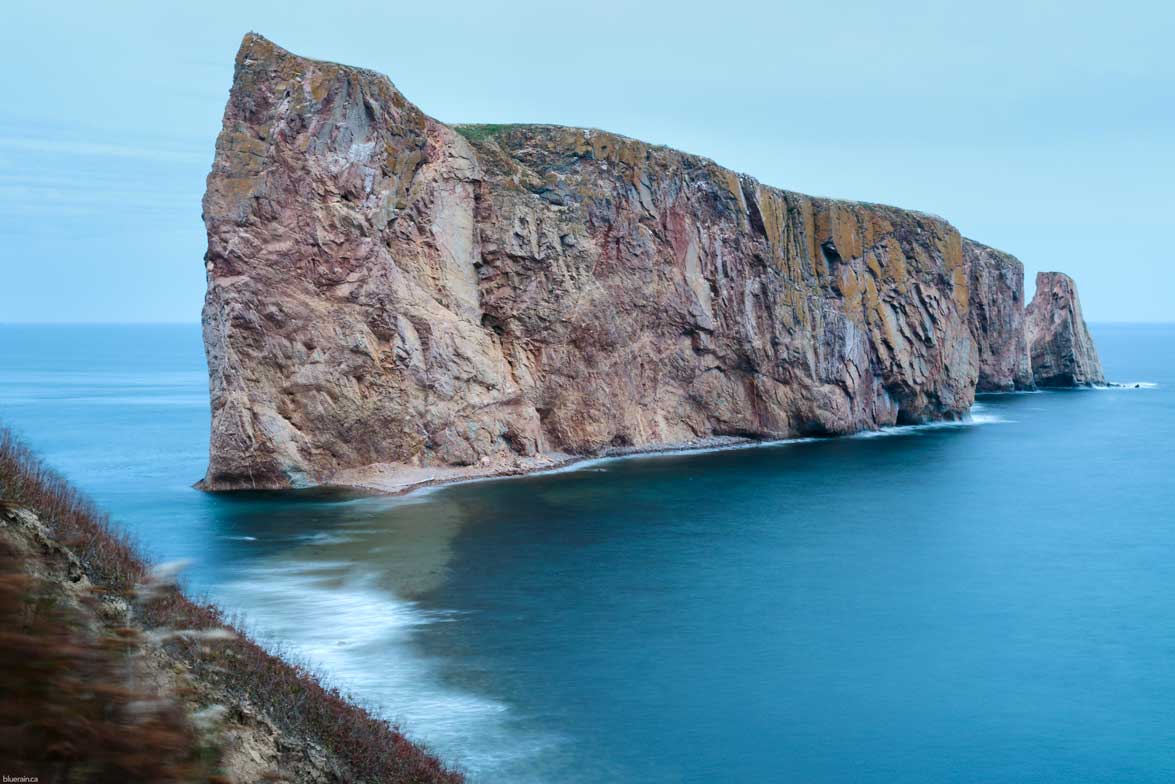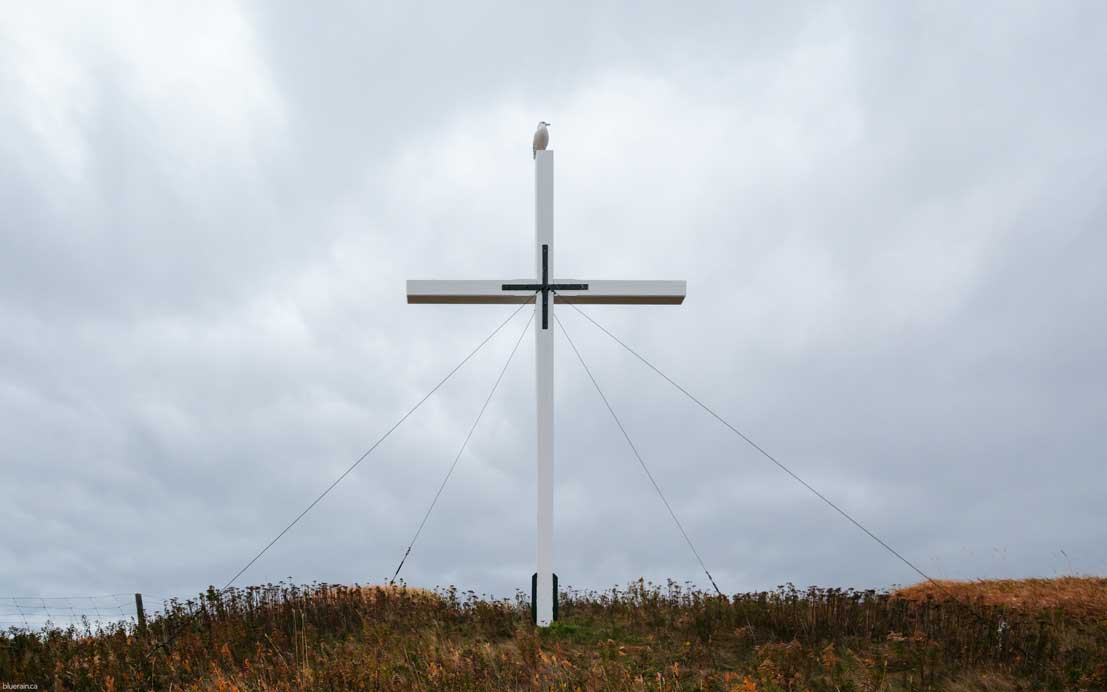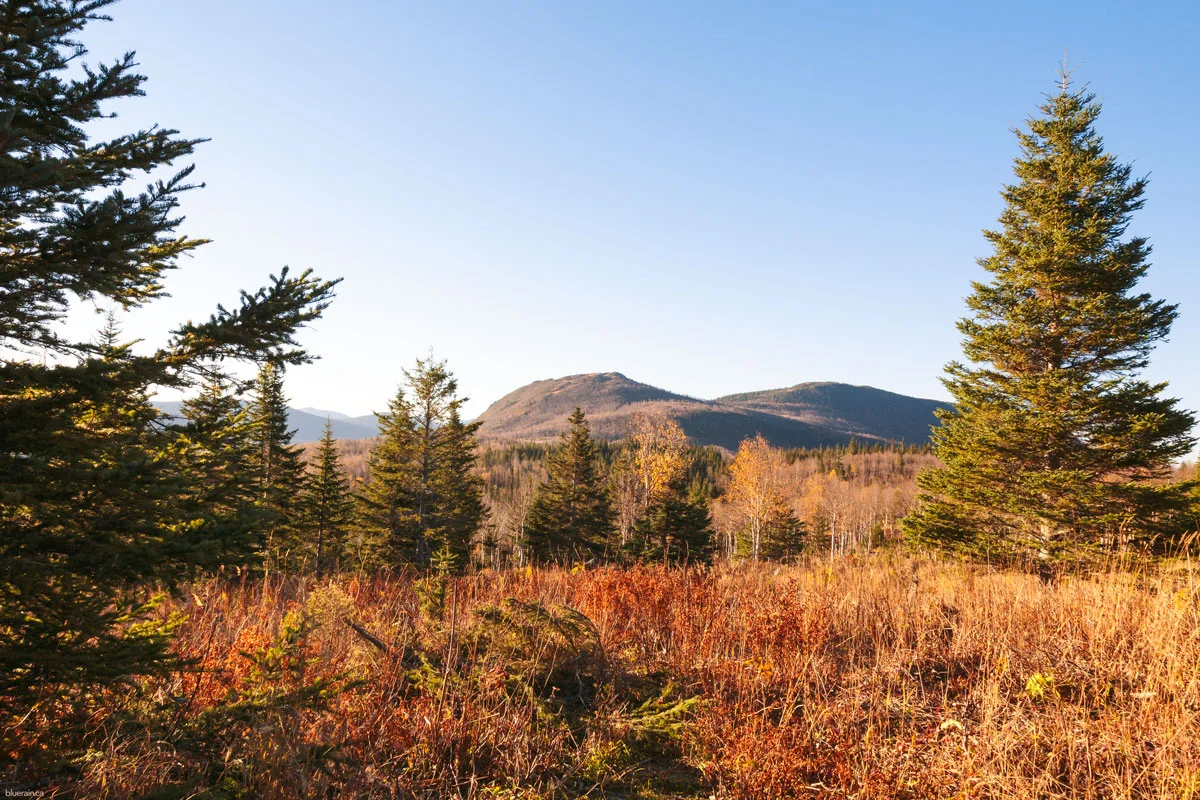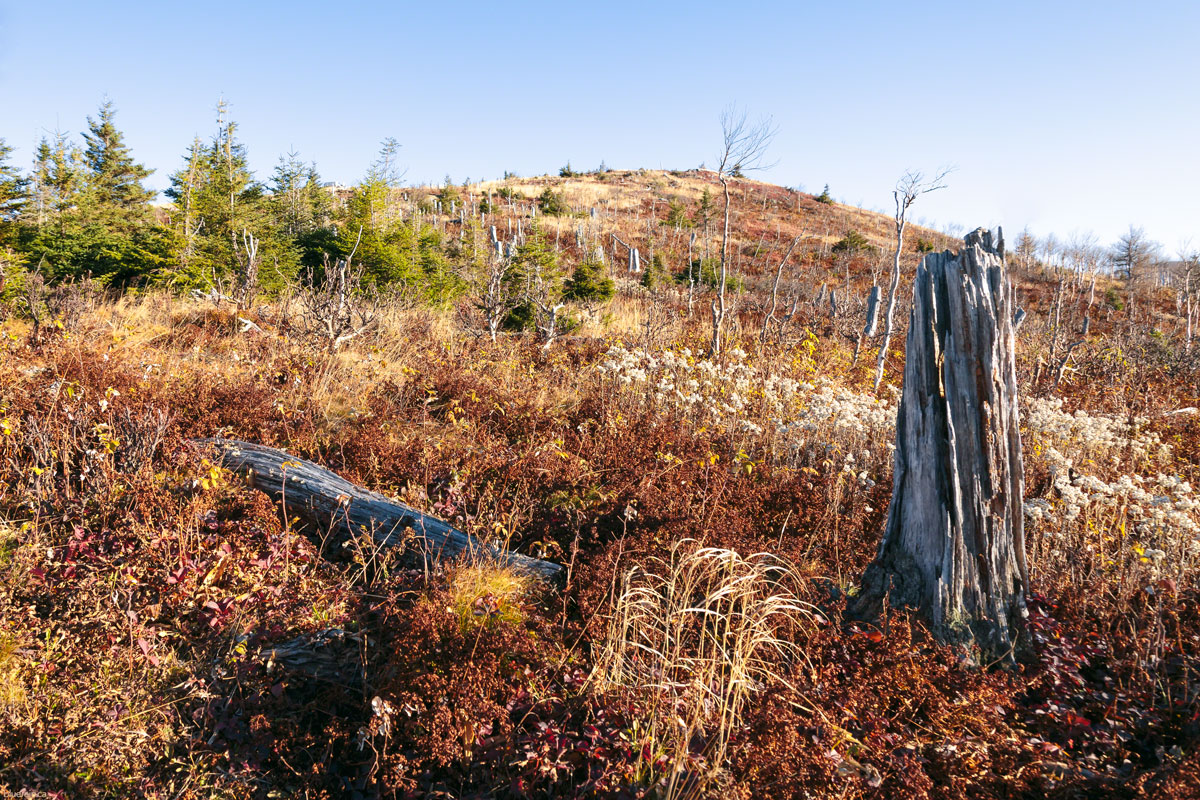Our last days in Quebec were spent at Forillon National Park, where we enjoyed views along the Atlantic and hiked the Les Graves trail out to the Cap Gaspe lighthouse. We were joined by a friendly porcupine and an inquisitive moose. We absolutely positively did not hear bears in the brush. We missed seeing the coastal drive west along the St. Lawrence river in daytime but we did end the trip with one of the most beautiful sunsets I’ve seen in my life.
Quebec
Percé Rock, Gaspé
The drive from Gaspesie National Park to the Gaspé peninsula and the Percé rock was absolutely stunning. Every bend in the road revealed the glory of fall in all its splendour - yellows, oranges, reds and greens.
We arrived in Gaspé in the late afternoon, and after checking into our hotel, headed to town for dinner and to view the famous Percé rock with its large natural arch. Early the next morning, only two of us managed to roll out of our warm, comfortable beds to head out in the misty drizzle to see the sun rise over the Atlantic. Unfortunately, we missed the sun as it peeked out for a handful of seconds as it rose over the horizon but we soaked up the quiet, gray atmosphere as we explored the peninsula - together, alone - while the rest of the town slept.
Gaspesie National Park: Hiking Le Mont-Ernest-Laforce
On our final morning in Gaspesie National Park we decided to hike Mont-Ernest-Laforce, an intermediate level 4,5 km trail. We left early and arrived as the sun was lighting the treetops. The weather and light were phenomenal - warm and golden. Given the early hour, we only saw two other parties on the trail, although there were many people starting the hike as we arrived back at the parking lot.
The trail wound its way through a forest and upwards above the trees to open and bare hilltops with stunning views. It was windy up top but we barely noticed, our attention on the 360 degree views. When breakfast began to beckon, we started back down the trail, pausing to watch a mama moose and her baby before heading back to the cabin, packing up and driving east to the tip of the Gaspe peninsula.
I spy moose.
Touring Gaspesie National Park
It's hard to believe that a full year has flown by since I first published this website and started blogging weekly. It's been a lot of fun and I would like to thank all you readers for dropping by regularly and for your kind comments. It wouldn't be the same without you!!
Our trip to Quebec to see the fall colours continued in Gaspesie National Park. Having arrived in the dark, we woke up to amazing views - towering hillsides of yellow with touches of orange and red. The weather was incredible for October - low 20s and sunshine - perfect hiking weather.
Read about the beginning of our trip as we visit Montreal and Kamouraska.
Eel fishing, Kamouraska and Parc National du Bic
The village of Kamouraska in Quebec is a hidden gem. Tucked up alongside the St. Lawrence river, Kamouraska has the most adorable rainbow coloured shops, charming bakeries with delicious French pastries and freshly baked bread, and cute cafes with great menus. Oh, and the houses are divine and include my dream B&B - yellow and white with porches and windows for days. I could retire here.
Kamouraska is known for its eel fishing, although there are only a handful of licensed eel fishers nowadays. Fishermen set up nets along the river to catch eels as the tides go in and out. These sea monsters make me a bit squeamish but they are an important part of the ecosystem and their numbers are declining rapidly due to pollution and the numerous dams that prevent their reproduction. Fishermen who used to catch thousands of eels now only catch a handful.
Continuing east, we stopped for a quick break at Parc National du Bic to stretch our legs and view the emerging fall colours.
A fall day in Montreal
Montreal is a city that we always travel through or around without ever taking the time to stop and visit. Mostly, I think, because it's too close to home and when we're on a road trip heading east the goal always seems to be to drive as far as possible on the first day. So when the opportunity arose a few weeks ago to spend several hours in the city, we started planning our adventure. Shortly after we arrived, however, it became clear that we weren't going to be able to visit even a fraction of the places on our list - the city was too big and beautiful. It would take days, if not weeks, to fully tour this historic, interesting and vibrant place.
We decided to explore the area known as Old Montreal on foot, walking the cobblestone streets through the market, past old stone buildings and gorgeous storefronts to the Notre Dame Basilica of Montreal. The interior of the Basilica was stunning and well worth the modest entrance fee. Afterwards, we wandered down to the waterfront, along Quai Jacques-Cartier - where the fall colours were starting to appear - ending at Terrasse Bonsecours, as a golden sunset turned the city aglow.
Eastern Canada road trip - Tadoussac to Mingan
In Tadoussac, we visited the Saguenay-St. Lawrence Marine park, one of three National Marine Conservation Areas in Canada. As mentioned in a previous post, two great rivers meet and stir up the nutrient rich waters, attracting a variety of marine life, including whales. We purchased a Parks Canada pass - our best investment of the whole trip. In 2017 all Parks Canada sites will be open to the public free of charge to celebrate Canada's 150th birthday - start planning!!
We spent a few days in the area - whale watching, visiting the different sites of the marine park, relaxing at a campsite with impressive views and sunsets and exploring the Louis Gravel covered bridge.
Saguenay–St. Lawrence Marine Park
Cap de Bon-Désir Interpretation and Observation Centre
Louis Gravel Covered Bridge
Saguenay fjords at L'Anse-de-Roche
We had planned to drive a loop around the Saguenay river and Lac Saint-Jean - the fjords were said to be spectacular - but Hurricane Irene had wiped out the road in several places. Luckily, we caught a brief glimpse of the towering giants at L'Anse-de-Roche.
As we got closer to the Mingan archipelago, the distance between villages became greater. The landscape changed - untouched by development. The number of English speakers dropped to zero.
A lobster fisherman from New Brunswick came for a visit when he noticed our Ontario plates. Weathered and darkly tanned, he was a born storyteller. He regaled us with tales of local traditions and about the woman he had fallen in love with and followed to the Mingan area some twenty years previous. Prior to his arrival, he told us, there was no electricity in their small village. Local fisherman, who needed to store their catch in a cold place in the summer months, would navigate their fishing vessels to a nearby small island with hills that were snow covered year round, fill their boats with snow, haul it back to the mainland and shovel it into well insulated storage sheds - their version of a freezer.
The system worked well, he explained, until the year he showed up those many years ago. His first summer in rural Quebec was also the last summer that the snow remained year round. Now, when spring arrives, the snows melt as the birds return north for the summer.
Although there are now roads to this region of the country and electricity in every house along the St. Lawrence, I can't help but wonder about the great adjustment these small villages must have experienced as their way of life changed and how they coped in the years after the weather warmed and before the modern world intruded.
The St. Lawrence river widened as we continued along the north shore until we could no longer see land on the other side. The rise and fall of the tides became more evident. Incredible. In 1858, Charles Mackay, editor of the Illustrated London News wrote, "Familiarity with [the St. Lawrence river] breeds no contempt. On the contrary, the more it is known, the more it is admired. Without exaggeration, it may be called the chief and prince of all the rivers in the world."



















































































